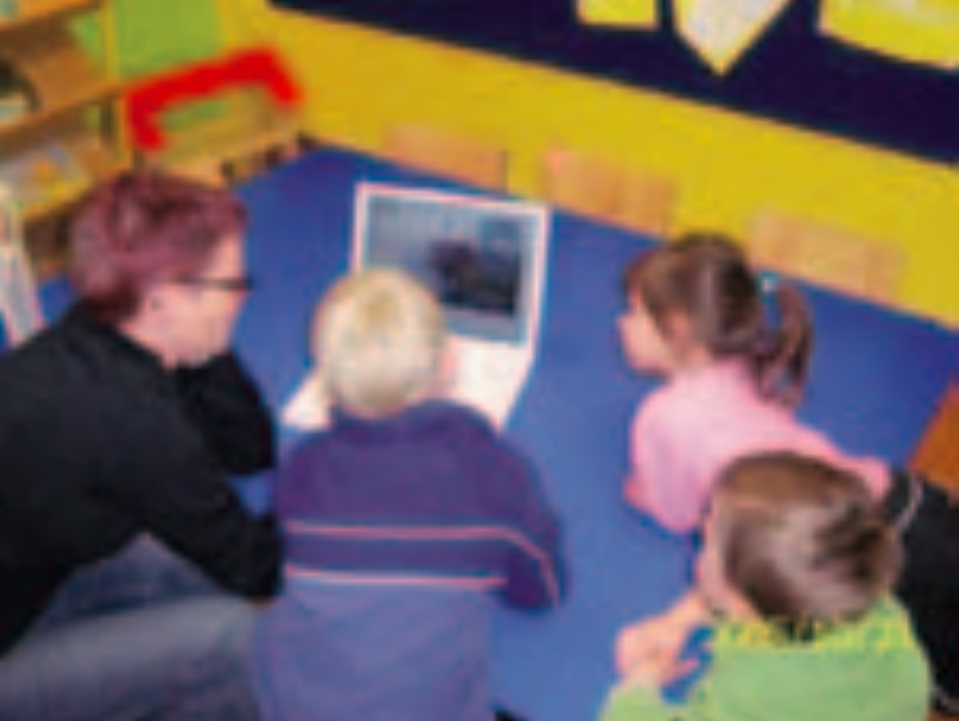Kei Tua o te Pae
Kei Tua o te Pae/Assessment for Learning: Early Childhood Exemplars is a best-practice guide that will help teachers continue to improve the quality of their teaching.
The exemplars are a series of books that will help teachers to understand and strengthen children's learning. It also shows how children, parents and whānau can contribute to this assessment and ongoing learning.
We are making improvements to our download-to-print functionality. So if you want a printed copy there are PDF versions available at the bottom of the main cover page.
Non-verbal communication skills for a range of purposes
-
Drawing and chanting together
11 August - Mūmū Te Āwha na Whaea Re-nee

Mūmū Te Āwha was watching Mira drawing on the whiteboard. She picked up a pen and began to draw alongside Mira, glancing over her shoulder to see what Mira was drawing then continuing with her own picture. After a short period Mūmū Te Āwha decided to use two pens, one in each hand, then changed to both in one hand. She drew circles with great concentration holding the two pens. She was very impressed with the outcome and asked Mira to look at her work. Mira smiled at Mūmū Te Āwha and carried on drawing. "Like this," said Mūmū Te Āwha. She started to sing to Mira, "Porohita, porohita."
Mira watched Mūmū Te Āwha as she made big strokes on the whiteboard then began to sing along with Mūmū Te Āwha, "Tapawhā, tapawhā." Mira's strokes became wider and longer as they sang, a lot similar to Mūmū Te Āwha's drawing. They carried on like this for a few minutes then put their pens away and went off to play in the sandpit.
I love to watch Mūmū Te Āwha do any type of art as I find her interesting as she goes through the motions. She is peaceful and takes care in what she is producing. Everything she creates has a purpose and has a meaning to her. In this instance Mūmū Te Āwha used singing as a stimulant to encourage Mira to draw the way that makes her happiest and is most satisfying. She wanted to share that feeling with Mira as she showed such a positive interest in Mira's work. We will expose you to a great lot more art experiences Mūmū Te Āwha and let your mind run free. He kōtiro rangimārie koe.
-
Introducing the computer
-
Child: Kaeleigh
Date: October
Teacher: Kimberly
Examples or cues A Learning Story
Belonging
Mana whenuaTaking an Interest Finding an interest here – a topic, an activity, a role. Recognising the familiar, enjoying the unfamiliar. Coping with change. Today we had a special visitor named Jo, who came in to talk to our teachers about ICT in our centre. Jo had a few spare minutes after lunch, so she brought her laptop out for us to play with. At first, we were looking at her photos on the laptop, and we all took turns at pressing the buttons to rotate through the photos. Then Jaimee asked if we could use the computer to write our names. Jo asked, “Should I put a page up so you can write your name? This is called Kid-Pix, which the children at my kindy use.”
When it was your turn, Kaeleigh, you typed the K and the A, but when you went to press the E, it typed EEE. You knew that there are not three E’s in your name, but you didn’t know how to fix it. Jo showed you where the delete key was, and you were away again, typing your name all by yourself.
Later on, when Jaimee was having a turn, she accidentally put in four A’s. You remembered how to delete the letters and showed Jaimee what to do to fix up her name.

Well-being
Mana atuaBeing Involved Paying attention for a sustained period, feeling safe, trusting others. Being playful with others and/or materials. Exploration
Mana aotūroaPersisting with Difficulty Setting and choosing difficult tasks. Using a range of strategies to solve problems when “stuck” (be specific). Communication
Mana reoExpressing an Idea or a Feeling In a range of ways (specify). For example: oral language, gesture, music, art, writing, using numbers and patterns, telling stories. Contribution
Mana tangataTaking Responsibility Responding to others, to stories, and imagined events, ensuring that things are fair, self-evaluating, helping others, contributing to the program. Short-term review
Kaeleigh, the teachers have learnt so much from Jo today, and I was really glad to see that you were learning some new things as well. You learnt how to do something new on the computer, and you were able to use this knowledge to help someone else when it was their turn.
Tino pai Kaeleigh
What next?
Kaeleigh, I’m sure that you would like to have another turn on the computer, and one idea we have had is to help you make a talking book on the computer. Does this sound like something you would like to do? We will talk about it and see what other ideas you have.
-
